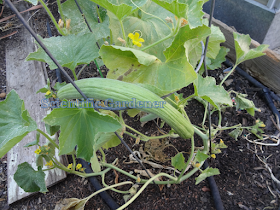A wonderful opportunity came to our family in the spring of 2018 when my son was given the opportunity to help mow the lawn and help weed at a friend’s home. The friend’s backyard once had an above-ground pool connected to a deck. After the pool was removed, he put grass where the pool once was and put a garden along the edges of the yard.
Over the years, he has incorporated his lawn clippings (without pesticides or herbicides) with high carbon material to make compost. He lets this sit for a year, then in the spring he mixes the compost with his garden soil and tosses any clumps of hard clay into the trash bin. The soil he tosses is much higher in quality than most people’s fertile soil. Along the edges he grows his vegetables. He mostly grows things he enjoys such as peas, pole beans, corn and tomatoes.
Over time, due to family demands, he has not had the opportunity to use the whole yard and, after receiving permission to plant a couple cucumber plants, he has allowed me to expand to much of his area. In return, I compost all of my plant material in his compost bin and keep the area basically weed-free while the plants are growing there. In addition, I have recently been adding my own compost to his already fertile soil.
The very first plants I grew were a mix of three different plants. One was a Medium Long of Tarantino, the other an unknown variety and that third was a medium long of Barese. The unknown variety and the medium long of Barese were from my friend Angelo. I grew all three of these in and around a little cube that the plants could trellis up.
Once I was mostly done growing these out, my friend allowed me to utilize some more space to grow out the Carosello Barese. Finally, I tried growing out the Carosello Tarantino from the seed packet one last time.
Over the years, he has incorporated his lawn clippings (without pesticides or herbicides) with high carbon material to make compost. He lets this sit for a year, then in the spring he mixes the compost with his garden soil and tosses any clumps of hard clay into the trash bin. The soil he tosses is much higher in quality than most people’s fertile soil. Along the edges he grows his vegetables. He mostly grows things he enjoys such as peas, pole beans, corn and tomatoes.
Over time, due to family demands, he has not had the opportunity to use the whole yard and, after receiving permission to plant a couple cucumber plants, he has allowed me to expand to much of his area. In return, I compost all of my plant material in his compost bin and keep the area basically weed-free while the plants are growing there. In addition, I have recently been adding my own compost to his already fertile soil.
The very first plants I grew were a mix of three different plants. One was a Medium Long of Tarantino, the other an unknown variety and that third was a medium long of Barese. The unknown variety and the medium long of Barese were from my friend Angelo. I grew all three of these in and around a little cube that the plants could trellis up.
Once I was mostly done growing these out, my friend allowed me to utilize some more space to grow out the Carosello Barese. Finally, I tried growing out the Carosello Tarantino from the seed packet one last time.
 |
| The end of the season along with powdery mildew |

















































